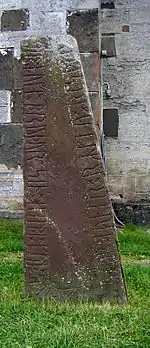| Granavollen stone | |
|---|---|
 | |
| Created | 11th century |
| Discovered | Gran, Oppland, Norway |
| Rundata ID | N 63 |
| Runemaster | Unknown |
| Text – Native | |
| Synir Aunar ryklu reistu (ep)tir Aufa bródur sinn. Hjalpi Gud sál Aufa | |
| Translation | |
| Aun R...s sons erected (the stone) in memory of Aufi, his brother. God have mercy on Aufi's soul | |
The Granavollen stone is a runestone located behind Nikolaikirken at Granavollen in Gran, Oppland county, Norway. This church is also known as one of the two medieval Sister Churches. The inscription is classified as being carved in runestone style RAK,[1] which is the oldest style. This classification is used for those inscriptions where the ends of the runic text bands are straight and do not have any animal or serpent heads attached.
The runic text is dated as being from the last half of the eleventh century[2] and reveals that the stone was erected in memory of a brother named Aufi. The text ends in a prayer for Aufi's sál, or soul, a word which was not used until after Christianization.[2]
Transliteration
A transliteration of the runic text into Latin letters is:
- × synir ¤ aunar ¤ rykiu ¤ risþtu [¤] ...(f)tir ¤ aufa ¤ bruþur ¤ sin ¤ hialbi ¤ kuþ × sol × aufa[1]
References
- 1 2 Project Samnordisk Runtextdatabas Svensk - Rundata entry for N 63.
- 1 2 Spurkland, Terje (2005). Norwegian Runes and Runic Inscriptions. van der Hoek, Betsy (trans.). Woodbridge: Boydell Press. pp. 133–135. ISBN 1-84383-186-4.
See also
- The Dynna stone